
Mexico Dynamic Load Management Systems Market Size, Share, Trends and Forecast by Component, Application, Technology, Deployment Mode, End User, and Region, 2025-2033
Mexico Dynamic Load Management Systems Market Overview:
The Mexico dynamic load management systems market size reached USD 14.4 Million in 2024. Looking forward, IMARC Group expects the market to reach USD 52.5 Million by 2033, exhibiting a growth rate (CAGR) of 13.8% during 2025-2033. The market is expanding due to the rising demand for intelligent energy control in AI-driven data centers and fully electrified homes. In addition, the focus on power efficiency and real-time load balancing continues to support Mexico dynamic load management systems market share across residential and industrial applications.
|
Report Attribute
|
Key Statistics
|
|---|---|
|
Base Year
|
2024
|
|
Forecast Years
|
2025-2033
|
|
Historical Years
|
2019-2024
|
| Market Size in 2024 | USD 14.4 Million |
| Market Forecast in 2033 | USD 52.5 Million |
| Market Growth Rate 2025-2033 | 13.8% |
Mexico Dynamic Load Management Systems Market Trends:
AI-Driven Demand for Power Precision
The growth of high-performance computing and AI deployment is redefining energy requirements in Mexico's data center infrastructure. The push for lower latency, faster processing, and dense rack configurations places considerable stress on existing power systems. Concurrent with this, operators now require smarter energy controls that can quickly react to fast, irregular load spikes. For instance, in October 2024, Vertiv introduced dynamic load management solutions specifically designed for AI environments in Mexican data centers. These systems were built to manage rapid voltage swings and thermal shifts caused by fluctuating GPU-intensive workloads. Furthermore, the technology allowed facilities to avoid instability and performance degradation by improving control over power delivery and integrating cooling systems with real-time load feedback. This shift not only preserved equipment but also reduced reliance on oversized backup systems, improving cost efficiency and space usage. The trend reflects a broader move toward adaptive energy infrastructure in mission-critical environments. As more industries invest in AI and machine learning, the need for load systems that can manage unpredictable power demand becomes critical. Vertiv's approach underscores that smart load management is no longer optional, it is now essential for data centers seeking to operate at peak efficiency while minimizing energy waste and equipment strain.

To get more information on this market, Request Sample
Residential Shift to Smarter Energy Use
Mexico dynamic load management systems market growth is being shaped by rising electricity demand in homes and the growing popularity of all-electric living. As residential appliances and vehicles place more strain on electrical infrastructure, homeowners and builders increasingly need systems that can balance and optimize power use without expensive upgrades. In response to this, ABB introduced the ReliaHome Smart Panel with Panel Guard technology in February 2025. The system introduced dynamic load management into residential settings, enabling homeowners to prioritize appliances, prevent overloads, and monitor their energy use through a mobile app. The innovation provided a more efficient method for handling circuit-level energy distribution, particularly in households that integrate electric vehicles (EVs), heat pumps, solar panels, or other high-consumption devices. This approach helped reduce the need for full-service upgrades, a major cost barrier for electrification. The success of such smart panels is driving wider acceptance of dynamic load tools in home electrification projects, especially in urban developments and retrofits. As more households seek efficient and cost-effective energy management, the demand for integrated, flexible solutions in the residential sector continues to drive market expansion.
Mexico Dynamic Load Management Systems Market Segmentation:
IMARC Group provides an analysis of the key trends in each segment of the market, along with forecasts at the country and regional level for 2025-2033. Our report has categorized the market based on component, application, technology, deployment mode, and end user.
Component Insights:
- Hardware
- Software
The report has provided a detailed breakup and analysis of the market based on the component. This includes hardware and software.
Application Insights:

- Renewable Energy Management
- Electric Vehicle Charging
- Smart Grid Applications
- Industrial Load Balancing
The report has provided a detailed breakup and analysis of the market based on the application. This includes renewable energy management, electric vehicle charging, smart grid applications, and industrial load balancing.
Technology Insights:
- Cloud-based Solutions
- IoT-enabled Devices
- Artificial Intelligence Integration
The report has provided a detailed breakup and analysis of the market based on the technology. This includes cloud-based solutions, IoT-enabled devices, and artificial intelligence integration.
Deployment Mode Insights:
- On-premises
- Cloud-based Deployment
- Hybrid Deployment
The report has provided a detailed breakup and analysis of the market based on the deployment mode. This includes on-premises, cloud-based deployment, and hybrid deployment.
End User Insights:
- Residential
- Commercial
- Industrial
The report has provided a detailed breakup and analysis of the market based on the end user. This includes residential, commercial, and industrial.
Regional Insights:
- Northern Mexico
- Central Mexico
- Southern Mexico
- Others
The report has also provided a comprehensive analysis of all the major regional markets, which include Northern Mexico, Central Mexico, Southern Mexico, and others.
Competitive Landscape:
The market research report has also provided a comprehensive analysis of the competitive landscape. Competitive analysis such as market structure, key player positioning, top winning strategies, competitive dashboard, and company evaluation quadrant has been covered in the report. Also, detailed profiles of all major companies have been provided.
Mexico Dynamic Load Management Systems Market News:
- May 2025: Monta advanced dynamic load management systems by enhancing intelligent power distribution for EV charging. The update improved charging reliability, prevented circuit overloads, and supported stable energy use. This development boosted market adoption by addressing efficiency challenges in high-demand EV infrastructure environments.
- March 2025: Nuvve secured a USD 400-Million contract from New Mexico to deploy EV charging, V2G, and microgrid systems. This supported dynamic load management system development by integrating scalable storage and grid-balancing tech, strengthening market growth through improved energy efficiency and grid reliability.
Mexico Dynamic Load Management Systems Market Report Coverage:
| Report Features | Details |
|---|---|
| Base Year of the Analysis | 2024 |
| Historical Period | 2019-2024 |
| Forecast Period | 2025-2033 |
| Units | Million USD |
| Scope of the Report |
Exploration of Historical Trends and Market Outlook, Industry Catalysts and Challenges, Segment-Wise Historical and Future Market Assessment:
|
| Components Covered | Hardware, Software |
| Applications Covered | Renewable Energy Management, Electric Vehicle Charging, Smart Grid Applications, Industrial Load Balancing |
| Technologies Covered | Cloud-based Solutions, IoT-enabled Devices, Artificial Intelligence Integration |
| Deployment Modes Covered | On-premises, Cloud-based Deployment, Hybrid Deployment |
| End Users Covered | Residential, Commercial, Industrial |
| Regions Covered | Northern Mexico, Central Mexico, Southern Mexico, Others |
| Customization Scope | 10% Free Customization |
| Post-Sale Analyst Support | 10-12 Weeks |
| Delivery Format | PDF and Excel through Email (We can also provide the editable version of the report in PPT/Word format on special request) |
Key Questions Answered in This Report:
- How has the Mexico dynamic load management systems market performed so far and how will it perform in the coming years?
- What is the breakup of the Mexico dynamic load management systems market on the basis of component?
- What is the breakup of the Mexico dynamic load management systems market on the basis of application?
- What is the breakup of the Mexico dynamic load management systems market on the basis of technology?
- What is the breakup of the Mexico dynamic load management systems market on the basis of deployment mode?
- What is the breakup of the Mexico dynamic load management systems market on the basis of end user?
- What is the breakup of the Mexico dynamic load management systems market on the basis of region?
- What are the various stages in the value chain of the Mexico dynamic load management systems market?
- What are the key driving factors and challenges in the Mexico dynamic load management systems market?
- What is the structure of the Mexico dynamic load management systems market and who are the key players?
- What is the degree of competition in the Mexico dynamic load management systems market?
Key Benefits for Stakeholders:
- IMARC’s industry report offers a comprehensive quantitative analysis of various market segments, historical and current market trends, market forecasts, and dynamics of the Mexico dynamic load management systems market from 2019-2033.
- The research report provides the latest information on the market drivers, challenges, and opportunities in the Mexico dynamic load management systems market.
- Porter's Five Forces analysis assists stakeholders in assessing the impact of new entrants, competitive rivalry, supplier power, buyer power, and the threat of substitution. It helps stakeholders to analyze the level of competition within the Mexico dynamic load management systems industry and its attractiveness.
- Competitive landscape allows stakeholders to understand their competitive environment and provides an insight into the current positions of key players in the market.
Need more help?
- Speak to our experienced analysts for insights on the current market scenarios.
- Include additional segments and countries to customize the report as per your requirement.
- Gain an unparalleled competitive advantage in your domain by understanding how to utilize the report and positively impacting your operations and revenue.
- For further assistance, please connect with our analysts.
 Request Customization
Request Customization
 Speak to an Analyst
Speak to an Analyst
 Request Brochure
Request Brochure
 Inquire Before Buying
Inquire Before Buying




.webp)




.webp)












